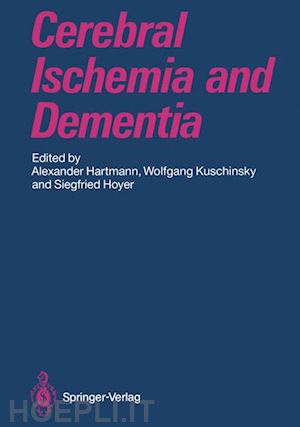How Does Cerebrovascular Disease Cause Dementia?.- Epidemiology.- The Epidemiology of Vascular Dementia.- Epidemiology of Vascular Dementia and Stroke in Akita, Japan.- Dementia in Stroke Survivors.- Pathology.- The Anatomical Substrate of Ischemic Vascular Dementia.- Vascular Dementia: The Search for a Correlate.- Incomplete Infarction Is an Important Component in Cerebrovascular Dementia.- Risk Factors.- Molecular Biology of Atherothrombotic Brain Infarction and Its Role in Vascular Dementia.- Cellular Aspects of Atherosclerosis and Approaches to Intervention: A Mechanism to Reduce Stroke and Vascular Dementia Risk.- Inhibition of Atherogenesis In Vivo and In Vitro.- Biochemistry and Pharmacology.- Alzheimer’s Disease: Role of Energy Metabolism and Treatment of Symptoms.- Neurochemical Changes in Brains from Patients with Vascular Dementia.- Subcortical Changes Following Ischaemic and Other Lesions of Cerebral Cortical Structures: Trophic Mechanisms and Neuronal Degeneration.- Experimental.- Selective Vulnerability of the CA1 Sector in the Gerbil After 5 Minutes of Global Ischemia: Relationship to Disturbances in Protein Synthesis and to Motor Hyperactivity.- Energy Metabolism in Cortex and Hippocampus During Aging, Ischemia, and Dementia.- Mechanisms of Glial Swelling from Lactacidosis and High K+-Levels in the Extracellular Compartment.- Potential Mechanisms Underlying Protection Against Cerebral Ischemia by Spontaneous Locomotion in Mongolian Gerbils.- Glutamate: A Role in Both Cerebral Ischaemia and Dementia of the Alzheimer Type.- Sabeluzole Enhances Spontaneous EEG Activity and SSEP, and Accelerates Their Posthypoxic Recovery in Rat.- Experimental.- Linkage Analysis in Italian Pedigrees with Autosomal Dominant Familial Alzheimer’s Disease.- RBC Aggregation Is Not a Primary Factor for Microvascular Stasis on Temporary Complete Ischemia of the Feline Brain.- White Blood Cell Behavior in the Cerebral Microcirculation.- Improved Learning with N-Methyl-D-aspartate Receptor Antagonist After Global Cerebral Ischemia.- Electrophysiological Markers of the Early Stages of Alzheimer’s Disease.- Diagnostics.- Neuropsychology.- Neuropsychological Assessment of Demented Patients.- Multiinfarct and Microinfarct Dementia.- Acute Aphasia.- Computerized Tomography, Magnetic Resonance Tomography.- Cerebral Hemodynamics in Patients with Periventricular White-Matter Lesions on Brain Imaging.- The Relation of Stroke to Leukoaraiosis.- Computed Tomographic Evaluation of the Cervical Carotid Artery.- Magnetic Resonance Imaging and Spectroscopy: A Unique Approach to Ischemic Cerebrovascular Disease.- Imaging Techniques and Neuropsychological Testing in Dementia with Severe White Matter Changes.- Stable Xenon Computerized Tomography.- Cerebral Ischemia Correlates Better with Cognitive Impairments in Mild to Moderate Multi-Infarct Dementia than Infarcted Brain Volume.- Regional Cerebral Blood Flow in Binswanger’s Disease.- Xenon 133-Cerebrography and SPECT.- Cognitive Utilization of Cerebral Vasomotor Reserve in Cerebrovascular Disease.- Tomographic Measurements of Regional Cerebral Blood Flow by SPECT in Vascular Dementia.- Contribution of HM-PAO-SPECT and 133Xe-rCBF to the Differential Diagnosis of Dementia as Experienced in Clinical Practice.- Intracerebral Reserve Assessment with SPECT: Reactivity to Acetazolamide and Cerebral Blood Volume Measurement.- SPÉCT Brain Imaging in Chronic Stroke and Dementia: A Comparison of 99mTc-ECD and 99mTc-HMPAO.- CSF ?1-Antichymotrypsin and Antitrypsin in Multi-Infarct Dementia and Alzheimer’s Disease.- Positron Emission Tomography.- Functional Recovery After Cerebral Ischemia: Studies in the Motor System.- Detection of Structural and Metabolic Changes of the Brain in Normal Aging and Dementia with Modern Imaging Techniques.- Subcortical Lesions and Dementia: The Role of Positron Emission Tomography.- PET Metabolic and Neuropsychological Correlates of Periventricular Lucencies.- Clinical Presentation.- Accuracy of the Antemortem Diagnosis and Neuropathological Features of Multi-Infarct Dementia.- Development and Evaluation of the Maudsley Mentation Scale for Bedside Measurement of Fluctuations in Cognitive Function in Patients with Acute Vascular Lesions: Comparison with the Glasgow Coma Scale.- Acute Confusional States After Stroke: Occurrence, Determinants, and Neuroendocrine Correlates.- The Prognosis of Stroke in the Elderly.- Thalamic Dementia and Pseudodementia.- Therapy.- Positron Emission Tomography in Cerebrovascular Disease: Implications for Therapy?.- A Clinical Trial of Pentoxifylline in Vascular Dementia.- Rheological Therapy of Vascular Dementia: A Rational Basis?.- Monosialoganglioside in Subarachnoid Hemorrhage.- GM1 Ganglioside Therapy in Acute Ischemic Stroke.- Communicating Hydrocephalus — Diagnosis and Management.- Assessment of CSF Volume in Normal Subjects and Patients with Dementia Due to Normal Pressure Hydrocephalus.











